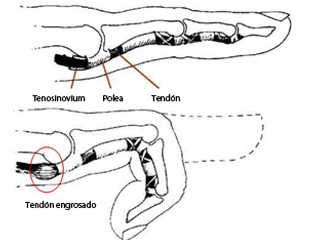Trigger finger is characterized by a dysfunction of the finger flexor tendon. It appears disparity between the flexor tendon and the surrounding pulley system. It is associated with pulley inflammation that blocks the finger movement across pulley resulting in difficulty flexing or extending it. The clinical training includes pain, snapping or locking of the involved finger.
Causes
Causes of this condition are not well defined, but the etiology seems to be idiopathic. Some trigger fingers appear in patients who suffer from rheumatoid arthritis, gout or diabetes. As well as it has sometimes been thought that repetitive trauma in the palm of the hand may be the cause.
Symptons
Trigger finger starts with pain at the base of the finger or thumb. Patients sometimes have an aching nodule when palpating the palm of the hand. An iterative forceful use of the digit leads to narrowing of the fibrous digital sheath in which it runs and it gets hooked. Even some patients need to straightening the finger with the help of the other hand.
Treatment
At the beginning, a conservative treatment is recommended by taking antiinflammatory medicines and using a splint. Often an injection of the tendon sheath and pulley with steroids is an effective relief.
When stereoids fail and the pain remains the same, the problem is resolved by a surgical procedure. It is a surgical technique carried out under local anesthesia and it consists of cutting the sheath that is restricting the tendon and the release of the pulley. In general, active movement begins immediately after the surgery. One week later the stitches can be removed, on the other hand pain may persist until the wound heals completely.






